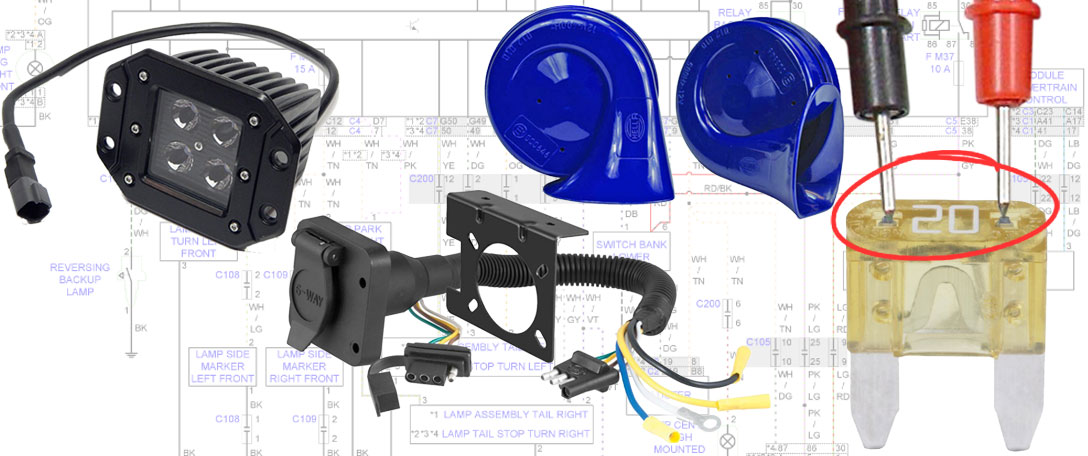Bellow
Hardcore MB Enthusiast
Came across the following here >> RockAuto November Newsletter
As the link will likely update to the most recent newsletter, here's a copy and paste of the article.
''
Backfeeding occurs when what should be the load side of an electrical circuit instead becomes a current source. One of the most infamous examples of backfeeding is when an improperly connected home generator sends electrical current out of the house and into the power lines, potentially shocking utility workers.
One way backfeeding happens in a car is when a failing component or incorrectly wired accessory enables the flow of rogue electrical current. This can be a bigger problem for newer cars with lots of computers because a relatively tiny electrical current travelling back up a wire might be all it takes to signal some control module to stay on. The control module thinks it is seeing a signal from a sensor or computer that it knows, but instead it is just receiving some electrical current noise that has followed a circuitous path to the module. The control module stays on and continues to draw power even after the driver turns the vehicle off. This parasitic loss can eventually drain the vehicle's battery.
My deputy sheriff son drives a seasoned 2017 Ford Police Interceptor Utility (Explorer) that occasionally exhibits electrical backfeeding symptoms. The car is loaded with (cool) electrical police accessories (lights, gun lock, computers, sirens, etc.). The accessories may not draw enough current to drain the battery but some of them periodically let a little rogue current flow out into the vehicle's wiring harness which fools a control module somewhere into staying on and that control module could drain the vehicle battery if the car sits for more than a couple of days.
Another source of backfeeding current can be a battery-equipped computer, toy or other device that is left plugged into one of the vehicle's power sockets (cigarette lighter). Once the vehicle is shut down, current might begin flowing out of the device into the wiring harness and eventually make its way to a control module that is tricked into turning on. First responders at car wrecks now look for devices still plugged into power sockets that might be generating enough current to cause sparks or keep something potentially dangerous like an airbag control module on. (A professional technician or DIYer should also unplug electrical devices left in a car before working on it.)

Parasitic current draws or backfeeding currents can be detected by checking for voltages across fuses. If there is a voltage then some current is flowing. The backs of fuses typically have small electrical contacts for a multimeter's probes (see image above). When installing your own (cool) accessories (lights, trailer wiring, horns...), try to get power from an unused fuse on the fuse block or at least a circuit with the fewest number of sensitive control modules.
Tom Taylor
RockAuto.com''
As the link will likely update to the most recent newsletter, here's a copy and paste of the article.
''
Backfeeding occurs when what should be the load side of an electrical circuit instead becomes a current source. One of the most infamous examples of backfeeding is when an improperly connected home generator sends electrical current out of the house and into the power lines, potentially shocking utility workers.
One way backfeeding happens in a car is when a failing component or incorrectly wired accessory enables the flow of rogue electrical current. This can be a bigger problem for newer cars with lots of computers because a relatively tiny electrical current travelling back up a wire might be all it takes to signal some control module to stay on. The control module thinks it is seeing a signal from a sensor or computer that it knows, but instead it is just receiving some electrical current noise that has followed a circuitous path to the module. The control module stays on and continues to draw power even after the driver turns the vehicle off. This parasitic loss can eventually drain the vehicle's battery.
My deputy sheriff son drives a seasoned 2017 Ford Police Interceptor Utility (Explorer) that occasionally exhibits electrical backfeeding symptoms. The car is loaded with (cool) electrical police accessories (lights, gun lock, computers, sirens, etc.). The accessories may not draw enough current to drain the battery but some of them periodically let a little rogue current flow out into the vehicle's wiring harness which fools a control module somewhere into staying on and that control module could drain the vehicle battery if the car sits for more than a couple of days.
Another source of backfeeding current can be a battery-equipped computer, toy or other device that is left plugged into one of the vehicle's power sockets (cigarette lighter). Once the vehicle is shut down, current might begin flowing out of the device into the wiring harness and eventually make its way to a control module that is tricked into turning on. First responders at car wrecks now look for devices still plugged into power sockets that might be generating enough current to cause sparks or keep something potentially dangerous like an airbag control module on. (A professional technician or DIYer should also unplug electrical devices left in a car before working on it.)

Parasitic current draws or backfeeding currents can be detected by checking for voltages across fuses. If there is a voltage then some current is flowing. The backs of fuses typically have small electrical contacts for a multimeter's probes (see image above). When installing your own (cool) accessories (lights, trailer wiring, horns...), try to get power from an unused fuse on the fuse block or at least a circuit with the fewest number of sensitive control modules.
Tom Taylor
RockAuto.com''
